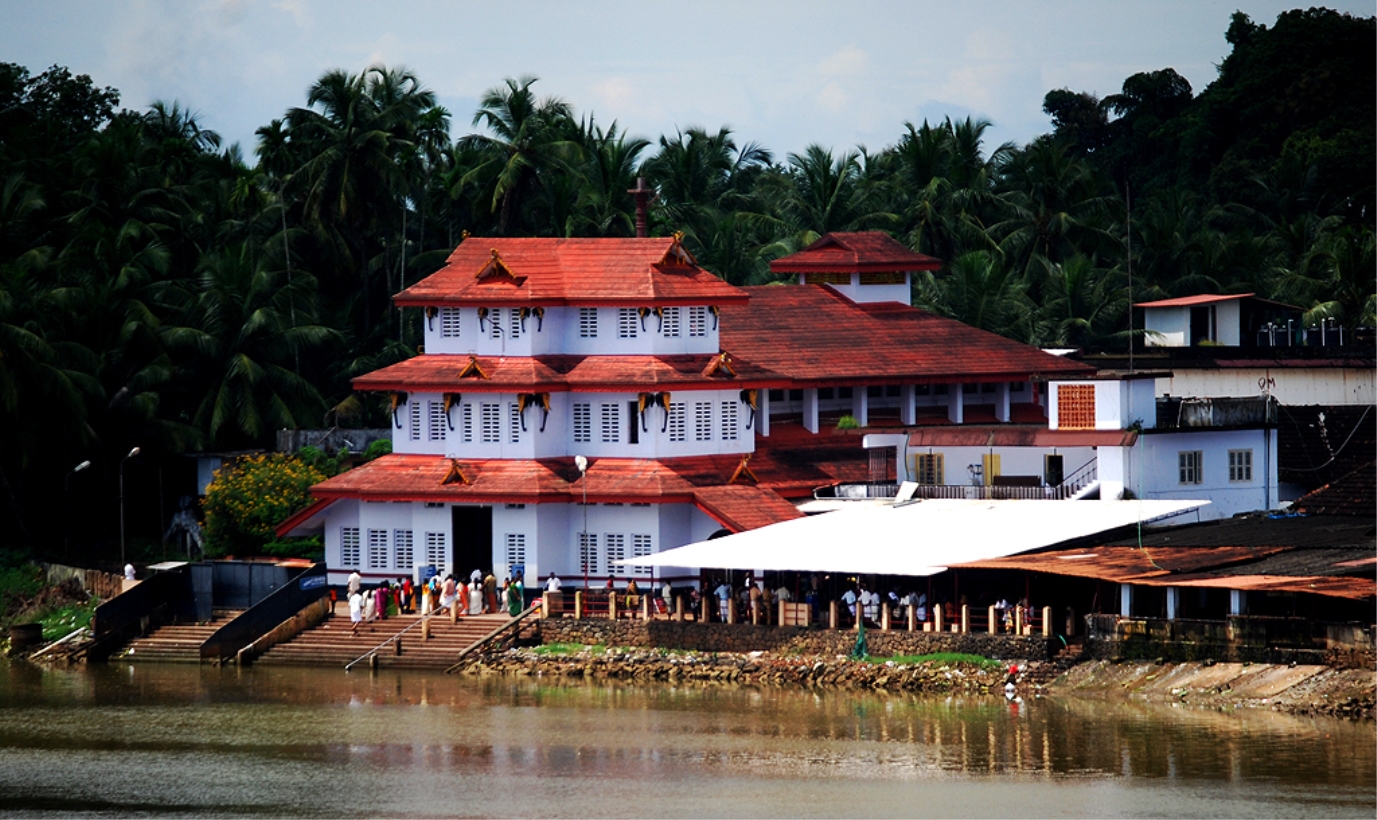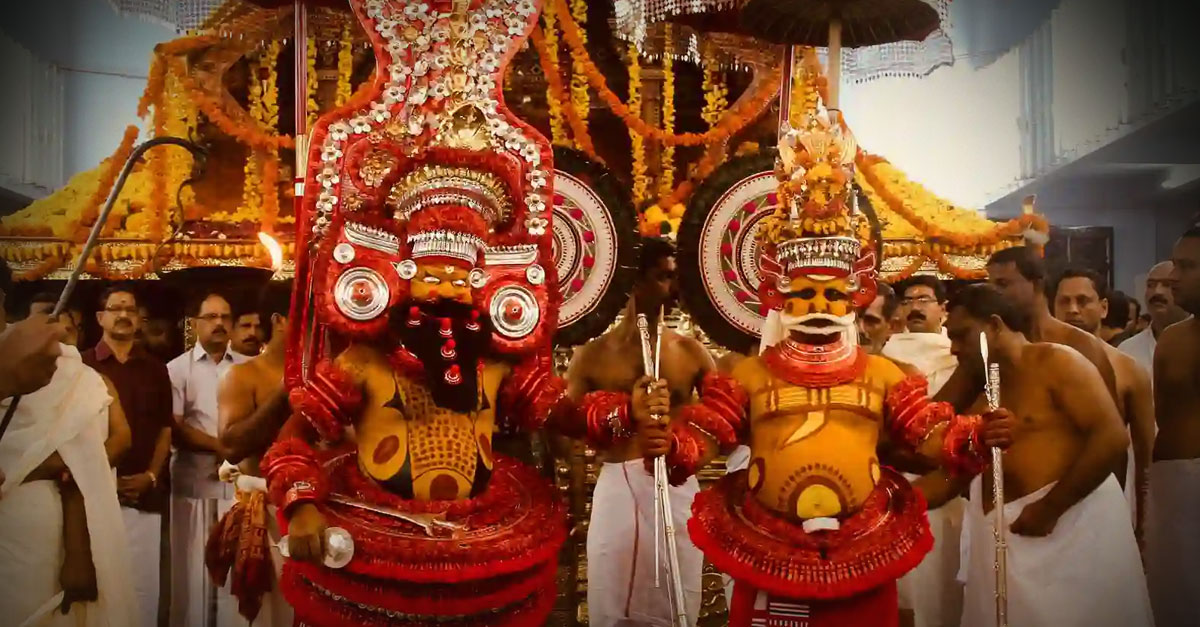Muthappan is a Hindu deity who is widely worshipped in Kerala’s Kannur, Kasargod, Kozhikode, and Malapuram districts, as well as Karnataka’s Coorg district. Muthappan is the embodiment of two Hindu gods: Thiruvappan or Valiya Muttapan (Vishnu) and Vellatom or Cheriya Muttapan (Vishnu) (Shiva).
Madappura is the name of the sanctuary where Muthappan is revered. The most important is the Parassinikadavu Madappura.
Muthappan’s devotion is distinct from that of other Hindu temples in that it does not follow the Sattvic (Brahminical) method of worship. The temple is open to individuals of all castes, faiths, and nations, and they are welcome to participate in the worship. Muthappan is also the primary god of the famed Parassinikkadavu temple’s traditional Theyyam dance (Muthappan Theyyam). Muthappan Theyyam’s ritual performers are from Kerala’s indigenous population. It is remarkable in that both upper-caste Brahmins and lower-caste tribals contribute significantly to the primary forms of religion in Kerala.
Practices
Muthappan is thought to be the embodiment of two divine figures: Thiruvappana and Vellatom. Thiruvappana and Vellatom, the twin god figures, are comparable to the Theyyamkaliyattem of northern Malabar. Though Sree Muthappan is regarded as a single god, it really depicts an integrated or united form of two gods: Vishnu (who wears a fish-shaped crown) and Shiva (who wears a lotus-shaped crown) (with a crescent-shaped crown).
Sri Muthappan’s Theyyams are performed all year, but other Theyyams are only done during certain seasons (lasting October to May).
Story of Muthappan
The background of the god is described in the traditional account of Parassinikkadavu Muthappan.
Ancharamanaykkal Vazhunnavar, the naduvazhi (ruler) of Eruvessi in Kannur, was sad since he had no child. Padikutty Amma, his wife, was a Lord Shiva devotee. For the sake of children, she offered a sacrifice to Shiva. She saw the Lord in a dream one day. She observed a gorgeous toddler laying on a nearby rock the next day as she was coming from a dip in a nearby river. (A rock that is said to be this one is still visited and revered today.) She took the youngster home and raised him as her own son with her husband.
The child used to go hunting with his bow and arrows  in the bush near their house (mana). He’d then distribute meals to the destitute and interact with indigenous tribes like the Thiyya. His parents pleaded with him to stop doing these things since they were against his way of life, but the youngster was deafeningly deafeningly deafeningly deafeningly deafeningly deafeningly deafeningly deafeningly deafeningly deafen Ancharamanaykkal Vazhunavar was extremely dissatisfied.
in the bush near their house (mana). He’d then distribute meals to the destitute and interact with indigenous tribes like the Thiyya. His parents pleaded with him to stop doing these things since they were against his way of life, but the youngster was deafeningly deafeningly deafeningly deafeningly deafeningly deafeningly deafeningly deafeningly deafeningly deafen Ancharamanaykkal Vazhunavar was extremely dissatisfied.
Ayyankara Vazhunavar decided to take charge of the situation and reprimanded him. His heavenly form (Visvaroopam, or Viswaroopa, or Cosmic All-Pervading Form) was shown to the boy’s parents. They recognised the youngster was not an average child, but rather God. They surrendered themselves to Him by prostrating themselves in front of Him. Due to his grief in leaving the house, everything that came into Muthappan’s eyesight burned and went to ashes the instant he walked out the door. His mother advised him not to stroll all the way across the planet, destroying everything. Muthappan punctured his eyeballs to ensure that nothing would be lost in his vision. As a result, Thiruvappana is shown as blind.
From Ancharamanaykkal, he embarked on a voyage. Kunnathoor’s inherent beauty drew Him in. The toddy of palm trees drew him in as well.
Knowing that his toddy was being taken from his palm trees, Chandan (an uneducated toddy tapper) determined to secure them. He caught an old guy taking toddy from his palms while on guard duty at night. He became enraged and attempted to kill the man with his bow and arrows, but he passed out before releasing even one arrow. Chandan’s wife had come to look for him. When she discovered him asleep at the base of the tree, she wept bitterly. She noticed an elderly guy at the top of the palm tree and addressed him as “Muthappan” (muthappan means “grandfather” in Malayalam). She prayed fervently to God to save her spouse. Chandan regained consciousness not long after. She served the Muthappan boiling gramme (chickpea), coconut slices, charred fish, and toddy. (Devotees are still served boiled grammes and coconut slices at Sree Muthappan temples nowadays.) She prayed for His blessing. At Chandan’s request, Muthappan picked Kunnathoor as his home. The renowned Kunnathoor Padi may be seen here.
After a few years in Kunnathoor, Sree Muthappan decided to hunt for a more suitable abode so that He might fulfil His Avataram goal. From Kunnathoor, he fired an arrow skyward. The shaft eventually made its way to Parassini, where the Parassini Temple now stands. When the arrow was discovered, it was blazing in the Theertha (holy water) near the temple. On the altar, the arrow was set. Lord Sree Muthappan is said to have lived at Parassinikkadavu since then.
Thiruvappan-Muthappan arrived at Puralimala near Peravoor after travelling through the bush. Thiruvappan introduced him to another muthappan, whom he dubbed cherukkan (Malayalam for “young kid”) and accompanied. Vellattam is the name of the second Muthappan (or Vellatom). There is a Muthappan named Thiruvappan – Valiya Muttapan (Vishnu) – and a second Muthappan named Vellattam or Cheriya Muthappan (Shiva). A round-shaped hay throne is used in the Theyyam for this.
Sree Muthappan and dogs
Sree Muthappan is escorted by a dog at all times. Dogs are revered in this shrine, and they may be seen in vast numbers in and around it.
At the temple’s entryway are two sculpted bronze dogs, which are thought to represent the God’s protectors. When the Prasad is ready, it is initially offered to a dog that is always on the lookout inside the temple grounds.
Local stories, such as the one below, emphasise the importance of dogs in Sree Muthappan:
Temple officials decided a few years ago to minimise the number of canines in the temple, so they removed several dogs and puppies. The performer of the Sree Muthappan Theyyam has been unable to perform since that day; it is stated that Sree Muthappan’s ghost inhabits the performer’s body for the length of the event. However, because the dogs had been gone, he most likely declined to enter the Theyyam performer’s body. The canines were returned to the temple once the temple administrators realised their error. Theyyam concerts resumed normalcy the following day.
Muthappan Temple
Parassinikadavu Muthappan temple is a temple in Kannur District, Kerala, India, located in Parassinikadavu in Anthoor Municipality on the banks of the Valapattanam river, about 10 km from Taliparambu and 16 km from Kannur City. The temple’s main deity is Sree Muthappan, whose divinity is shown in two variants, Thiruvappan and Vellattam, as a ceremonial theyyam performance. The reigning deity is said to be an incarnation of Lord Shiva, according to local legend.

Vellattam and Thiruvappan are general names for two varieties of’Theyyam Ketti-aadal’found in North Malabar’s kavu/temples.
Vellattom is a simplified variant of the ritual enactment in which the ornaments, decorations, and parapharnelia are kept to a minimum. As a result, all activities, including vaaythari (speaking) and Attam (dancing), are maximised. When compared to a deity’s idol in a temple sanctuary that is erected according to sathwic sasthra and vedic procedures, Vellattom is on par with the idol alone without the prabha-mandalam that surrounds it. The Seeveli ritual, with simply the little idol on top of the elephant, is a simpler example.
Thiruvappana, on the other hand, is the full form, complete with royal regalia and a larger prabhamandalam. The movement is little and slow since the decorations are greater and are of a binding type, and the uriyaadal (replies to prayers) will be sharp, to the point, and forecasts will be correct. Thiruvappana is comparable to the temple idol, which has the Prabha-mandalam (representing the auric circle) surrounding it, and the Seeveli, which has the large Swarna-Kolam covering the little deity on top of the elephant.
Muthappan is thought to be Lord Shiva himself manifested in a Nayattu (hunting) form. The Vellattam that appears first is Siva himself in his most basic form. However, the Vellattom, which appears later with the magnificent Thiruvappana of Muthappan, is a stripped-down form of Vishnu who, according to legend, came to Siva’s aid when he began travelling with the poykannu (blindfold) and began having major issues travelling and hunting for sustenance.
Mantra
Gayathri Mantra
The hymn RV 3.62.10 has the major mantra. The hymn is preceded with om (ॐ) and the phrase bhur bhuvah svah (भूर् भुवः स्वः) during its recital. The Taittiriya Aranyaka (2.11.1-8) correctly describes this prefixing of the mantra, stating that it should be repeated with the word om, followed by the three Vyahrtis, then the Gayatri stanza. Although the gayathri mantra calls for three padas of eight syllables each, the wording of the verse preserved in the Samhita is one short, with seven instead of eight syllables. The documented tri-syllabic varenyam would be emendated with a tetra-syllabic vareniyam under metrical restoration.
ॐ भूर्भुवः स्वः
तत्सवितुर्वरेण्यं
भर्गो देवस्य धीमहि
धियो यो नः प्रचोदयात् ॥
oṃ bhūr bhuvaḥ svaḥ
tat savitur vareṇyaṃ
bhargo devasya dhīmahi
dhiyo yo naḥ pracodayāt






